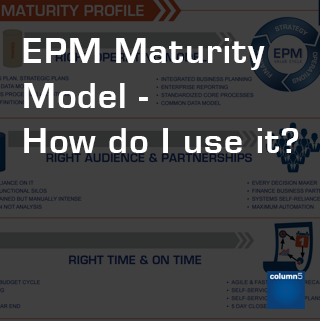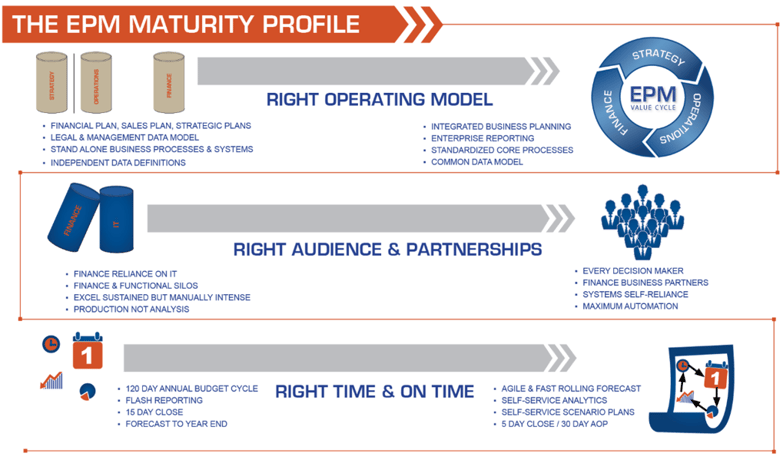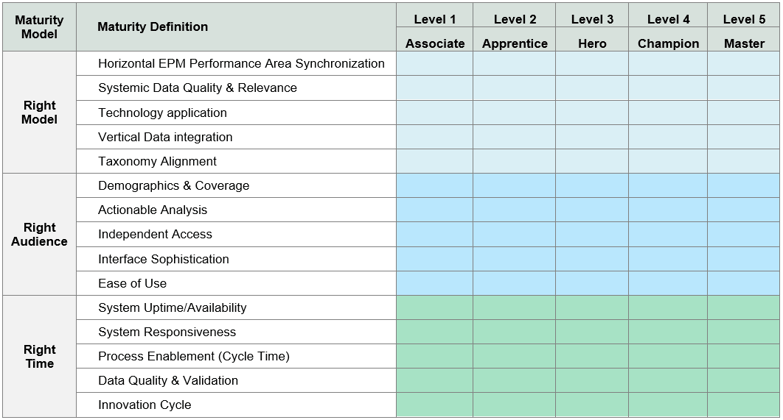 In the last article we looked at the definition and content of the EPM Maturity Model.
In the last article we looked at the definition and content of the EPM Maturity Model.
In this article we’ll look at how to gauge EPM Maturity and how to identify areas to improve. At the core of the Maturity Model is the definition of:
- Right Model
- Right Audience
- Right Time
Across these definitions we lay a scale that moves from low levels of maturity to high levels of maturity:

The main characteristics of low levels of EPM Maturity include:
- Disparate and silo planning approaches across all EPM processes with no integration
- High reliance on manual spreadsheets for individual processes
- Limited audience for both planning contributors and consumers
- Infrequent, high latency planning and forecasting
- Low confidence in the data and output from plans and forecasts
- Low use of plans and forecasts for decision-making
- Low level of investment across technology and people for EPM
The main characteristics for high levels of EPM Maturity include:
- High integration between Strategic, Operational and Financial planning processes
- Use of best practice functional EPM models / content
- Tight EPM model integration with relevant data sources
- High levels of automation for processing data, rules, calculations, workflow and process flows
- High reach to relevant users and audience
- Easy, intuitive, familiar user experience for EPM interactions
- “Mission critical” reliance on EPM processes for decision making and analysis
- Frequent, low latency planning and forecasting
- High ROI on investment in EPM technology and people
To gauge and profile EPM maturity for a particular organization a more comprehensive “matrix” of critical elements of the Maturity Model and levels of proficiency is needed. There is specific content in each cell of the matrix (not shown) that provides the more detailed definition of each level.

From each cell an objective analysis can be ascertained for an individual organization’s relative EPM capabilities. This approach can be overlaid on top the major EPM processes across Strategy, Operations and Finance to build up a comprehensive maturity model. Once in place, the maturity model will help identify immediate (priority) areas for improvement (maturing) that will provide clear benefits to the organization and provide an onward roadmap for delivering high value, successful EPM processes.
To effectively profile, gauge and improve EPM is highly valuable and important undertaking. The EPM Maturity Model is an invaluable aid in the approach to deriving a sustainable, successful approach for organizations.
Interested in learning about the differences between the new SAP BPC product versions such as BPC 10.1 Embedded and 10.1 Standard? Download the guide below!
Related Articles:
EPM Maturity Model - What is it?
11 Dirty Secrets of EPM Projects - Part 1
11 Dirty Secrets of EPM Projects - Part 2
EPM Project Management Methodologies Untangled
Top 5 Critical Success Factors for your EPM Project
Author Bio:
 Peter Bull is VP of Solutions at Column5 and is responsible for the company’s product development. Peter has over 25 years of experience in the area of business intelligence and delivery of enterprise software solutions including hands-on roles as a CFO. Prior to joining Column5, he was Group Program Manager for Microsoft Corporation’s SharePoint Business Intelligence Product Team.
Peter Bull is VP of Solutions at Column5 and is responsible for the company’s product development. Peter has over 25 years of experience in the area of business intelligence and delivery of enterprise software solutions including hands-on roles as a CFO. Prior to joining Column5, he was Group Program Manager for Microsoft Corporation’s SharePoint Business Intelligence Product Team.











